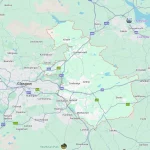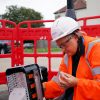Government Hails Start of National Campaign for UK Digital Phone Switch

The UK government has today hailed the start of a new national campaign, funded by broadband giants BT and Virgin Media, which aims to help support and encourage vulnerable people in their efforts to switch from legacy phone lines to new digital (IP / VoIP based) networks before the deadline.
In case anybody has forgotten, the big analogue phone switch-off was recently delayed to 31st January 2027 in order to give broadband ISPs, phone, telecare providers, councils and consumers more time to adapt (details). The main focus of this was the 1.8 million UK people who use vital home telecare systems (e.g. elderly, disabled, and vulnerable users), which aren’t always compatible with digital phone services (i.e. telecare providers were slow to adapt). For everybody else, the switchover deadline is still technically Dec 2025.
The industry-led shift is being driven by the looming retirement of copper lines in favour of full fibre (FTTP), as well as future exchange closures and the declining reliability of the old phone network (Ofcom states that related fault rates substantially increased by 45% in 2024). Not to mention that it is not economically feasible to maintain both the old and new networks side-by-side long term.
Advertisement
The government has already responded to these concerns by encouraging the industry to adopt various changes and work more closely together (here and here). For example, operators must now ensure that no vulnerable customers are migrated by the major providers (e.g. BT, Virgin Media, Vodafone and Sky Broadband) until their telecare systems have been confirmed to work with the new digital phone service. The latter may involve engineer visits to homes, as well as the offer of a free battery back-up device (protection during power outages) and more.
However, the new national awareness campaign (National Telecare Campaign) recognises that some problems remain, such as with the fact that not all elderly and disabled people may be aware of this change or how to solve it. In addition, not all internet and phone providers will have accurate knowledge of exactly which customers could be defined as “vulnerable” in the first place.
The new campaign thus seeks to encourage vulnerable users to identify themselves and contact their provider, assuming they haven’t already done so. Many local authorities and private telecare operators have already signed data sharing agreements with phone providers to ensure that as many telecare users have been identified as possible, but even these are not perfect.
Telecoms Minister, Sir Chris Bryant, said:
“We cannot afford to leave anyone behind during the vital transition to digital landlines. I have personally set a strict checklist of safeguards for industry to comply with before they migrate any telecare user.
This industry-led campaign marks a further step towards keeping people safe as we boost the resilience of our networks for the digital age.
I urge anyone with a telecare alarm – or anyone close to a user of a telecare alarm – to pick up the phone and contact their provider to access the help that’s available.”
From today, adverts will appear across TV, newspapers, social media and select radio stations around the country running over the next few months to ensure widespread reach (digitalphoneswitchover.com). This is coupled with newly created posters which will be on display in GP surgeries, hospitals, pharmacies and post offices.
Advertisement
The advertising campaign is expected to be seen by 95% of all adults in the UK, including 98% of those over 65. BT and Virgin Media landline customers can also call on 150 from their home phone to get more information (both have the highest population of landline-only users).
Claire Gillies, BT Group’s Consumer CEO, said:
“Moving customers onto newer digital services is a necessary step as the reliability of the 40-year-old analogue landline technology is increasingly fragile – therefore the time to act is now.
The Digital Switchover project requires team collaboration, so we’ve been working hard with industry partners and are really pleased to have the support of Government in helping us raise awareness and drive action.”
Rob Orr, COO at Virgin Media O2, said:
“With traditional analogue landlines becoming less and less reliable, the programme is essential step to safeguard services for the future. Inaction would mean putting services at risk.
Our message is clear: if you or someone you know use a telecare alarm, pick up the phone and talk to your provider. Let us know, and we’ll support you every step of the way.”
Since 2017, UK operators have been carrying out work to retire the decades old copper home phone network, which is reaching the end of its service life (in some ways it’s already gone past that), and move customers to digital landline services ahead of the analogue switch-off. “With over two thirds of landlines already migrated, the campaign is the final layer of protection to identify any additional users,” said today’s announcement.
Admittedly, the current effort should really have happened several years ago, but better late than never. Most of those who migrate today will already have a broadband line, which is needed for IP based digital phone services. But for those without broadband, BT will provide a special dedicated landline service, requiring no new equipment or engineer visit. This will ensure these customers can continue using their landline in the same way they do today, until 2030 (this is when the old exchanges start to be retired at scale).
The above reflects BT and Openreach’s launch of a new Pre-Digital Phone Line (PDPL) product (aka – SOTAP for Analogue). This essentially replicates how the old phone service worked, albeit over a more modern network (i.e. it does NOT require broadband or battery back-up to function). But this is only available to vulnerable and edge use case (inc. CNI) users on existing lines (not new customers) who would otherwise “face challenges” in migrating to IP based voice solutions by the deadline.
Advertisement
Mark is a professional technology writer, IT consultant and computer engineer from Dorset (England), he also founded ISPreview in 1999 and enjoys analysing the latest telecoms and broadband developments. Find me on X (Twitter), Mastodon, Facebook, BlueSky, Threads.net and Linkedin.
« Brsk Cuts Standard Price of 900Mbps UK Broadband to Just £35
Broadband ISP TalkTalk and Sky UK Battle Over NOW TV Fees »























































Don’t like to be negative, but I know many customers who have popped along to their library to be told by BT advisor’s they were going to be moved to Digital Voice, only to find over a year later nothing has happened! Maybe this time will make the difference, but I doubt it!
At the moment as far as I know you are not forced to go digital if you have an existing analogue line, If digital becomes available you can choose to change but currently do not have to
https://www.bt.com/help/landline/moving-to-dv/dv-landline-only
Most consumers will be picked up by ISP communication both contract end and mid contract. For the diminishing number of consumers who still take a landline only product from BT or CP using the PSTN will be transferred to a DV service using limited SOGEA or FTTP products.
Businesses using PSTN products will see their product discontinued.
@Bob: BT contacts users about migration to DV or to PDPL if they have no broadband. Nobody has to agree but then they will lose their phone service – which seems rather dumb to me.
The article fails to mention the approach that CPs that have a service based on local loop unbundled analogue voice services, eg. TalkTalk might or might not be taking to migrate customers. TT are still offering two year contracts of LLU xDSL and analogue voice where FTTP does not exist.
Quite why Telecare providers are dragging their heels who knows, They have been aware of the change for years so should have been ready for it
The usual reason I suspect…… It costs them money.
It might help if they published a list of Telecare devices that are compatible with digital and a list of those that are not
To be clear the service description is:
• Pre-Digital Phone Line (PDPL) is an exchange based Voice over IP service that is presented as an analogue service over the existing copper line to a customer premises.
• PDPL is a product offered as a “Best Efforts” replacement service to existing copper WLR3 (PSTN) lines. Only working PSTN/WLR3 single lines with BT can migrate to Pre-Digital Phone line. PDPL is a standalone service and cannot be offered in conjunction with any other service, such as broadband.
• PDPL supports many types of analogue end users and devices via a analogue voice service. This service is designed to match & resemble PSTN as closely as possible.
• BT does not take any responsibility the device connected to PDPL service will work. If you have any doubt your device will work with the PDPL service please visit PDPL test labs in Adastral Park to test it.
• PDPL is considered a temporary product and customers should pro-actively seek an All-IP alternative where possible.
It also priced at over £60/m. So it clearly set as a fall back to protect BT in case companies, local authorities etc (whether they make or supply or use) don’t get a move on with their IP based solutions. Long over due and finally allows BT to progress.
Yes it is primarily OR only but LLU suppliers will need to migrate at some stage soon so it will be good if they are also put under the same pressure. As the fault rate increases on copper it will become more important to transfer to IP solutions for both reliability and cost however much someone wants to hang on to a copper landline.
This isn’t about FTTP. Most people moving to digital voice will be doing so on a copper last mile.
DV is about closing the ageing PSTN while it can still be done in a controlled fashion. The move to FTTP will take place over much longer timescales.
Now that OR have over FTTP coverage of over 18m now and by the end of the year over 20m. It may be done in two stages (like my BT line – DV on FTTC then transferred FTTP) but in many cases it will completed as a single changeover (possibly including new Router).
The two BT targets this year for FTTP take-up and PSTN line closure are more likely being combined into a single change for the customer in the OR FTTP covered areas.
Yes those that will remain on copper for some time will be converted to SOEGEA/DV. But this will be an ever decreasing percentage of the current PSTN lines. With the PSTN target going back to Jan 2027 they have another year to progress on FTTC based DV conversion.
No, they won’t be combined. The PSTN must close. Moving people to FTTP requires Openreach’s customers, the ISPs, to sign new contracts with their end customers. Moving people to FTTP is not in Openreach’s control because they have no relationship with the end customers.
As I said, the two things are separate projects with separate timelines.
We have an PSTN phone line from BT Retail and, like the majority of BT Retail’s customers, we do not have a BT Broadband circuit.
And BT Retail has made no attempt to even contact us about switching to digital.
Frankly, it appears as though BT Group’s plan is to completely ignore customers who do not pay for a BT Broadband circuit.
It is looking more and more like millions of PSTN phone lines are going to be intentionally “orphaned” by BT Group.
Let us all remember that BT Group has been talking about the digital switch since before 2015, i.e. for at least 10 years, which incidentally was the year that Germany completed its digital switchover.
It kind of feels like the incumbent has slowed things down to suit itself, to the detriment of its customers and the British public. And even now it really doesn’t feel like it is even trying to do the best it can.
Hi,
I am stunned at your assertion that the majority of BT Retail’s customers don’t take a broadband service – can you point me to the evidence for that?
Why do you think you will be ignored and your phone line orphaned (whatever that means – I didn’t know that phone lines had parents!) – I can’t see any evidence for that either?
Given that the people shouting loudest at the moment are those saying “how dare they take away our analogue PSTN lines and convert us to digital” it is refreshing to hear someone putting forward the opposite view. Those shouting loudly have prompted a cautious approach to mass conversion so you may be seeing the effects of that.
It is unclear how you are suffering a detriment – a conversion to digital will bring you no additional benefits – you will still have a phone line you can make calls on, nothing more. That is perhaps why some are complaining – a change is happening and it seems to be inconvenient without really changing anything much at all (except perhaps the oft discussed power issue).
The mere existence of the PDPL product would go against your claims. That is the medium term solution for those who can’t (rather than won’t) be migrated. Of course PDPL doesn’t cover those who have some kind of broadband service on the line, but I doubt BT will be too worried if those customers decide to go elsewhere.
Germany isn’t all roses either (Google suggests PSTN switchover completed in 2018 or 2019, by the way), with DTAG struggling to get people onto FTTP. At least BT seems to have no problems there.
It isn’t BT that has “slowed things down”. Why would they want to maintain an increasingly risky and unmaintainable infrastructure any longer than they have to? Ironically if the 21CN project had proceeded as originally planned, the UK would have completed its PSTN switchover decades ago.
Do you mean your broadband is from a different supplier to BT or you don’t have broadband full stop? I would have thought the vast majority of customers in this country are now on combined packages.
@The Provisioner: You know that PSTN is going and if you haven’t been contacted by BT then give them a call yourself! If you can get broadband then do so and you’ll get DV via the BT Smart Hub 2, but if for some reason you can’t get broadband then you’ll be offered PDPL.
As usual there’s lots of effort and expense landing at the feet of BT, Virgin Media etc. and very little being done by the telecare service providers who are happy to keep billing for 15-year-old care alarms and not lift a finger to modernise them.
A very fair point.
There has been no rush to design and supply updated telecare devices.
@ the provisoner
think it depends on the telecare provider. neighbour got a new telecare device/base unit, a good 18 months to 2 years ago and works via mobile, as she has digital voice
On that link it states “Government’s ambition that everyone in the UK will have access to full fibre or gigabit-capable broadband by 2025” – I thought the Project Gigabit expectation was 85% coverage by 2025 and it will be more like 2030 for nearly 100% access?
Just helped a local church move to digital voice. Due to very poor Mobile signal the property (despite being in the centre of the village), Battery Backup was recommended and indeed provided for free. As a long term Telecomms Professional now retired I’m embarrassed to see the solution is 2 separate identical lead acid battery units – one for the Fibre ONT and one for Hub/Router. Surely we could have done better than that!
Both 12v but different size plugs. The ONT belongs to Openreach and the router to the ISP?
Just leave it all to Moira Stuart, busy, busy, busy! 🙂